The Victorian Era lasted for roughly 64 years (1819-1901). Throughout the reign of Queen Victoria, the British Empire witnessed prosperity in various aspects, including, and not limited to, industry, economy, religion, politics, architecture, government, theatre, music, art, culture, society, gender, and caste.
Another important and rather a significant surge was in the sartorial elegance fostered in the Victorian period.
Due to the advent of economic growth and technological advancement, there was a massive production of sewing machines in 1850. It brought about radical changes in fashion since clothes could be made faster and cheaper.
The clothes were differentiated by class as it was an expression of the estate one belonged to. At the same time, the upper-class women donned elaborate pieces, those from modest backgrounds dressed modestly, and the lower-class people, whatever they could afford.
In this article, I have compiled a list of 20 notable fashion trends of both men and women during the prosperous years of the Victorian Era.
20. Victorian Bags
Content
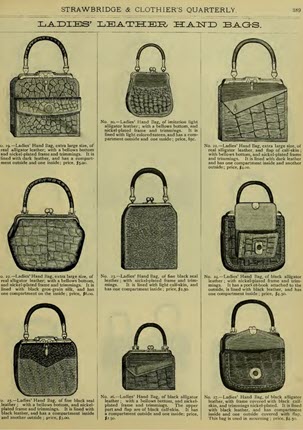
Chatelaine bags or chain bags were in trend during the Victorian Era. They were suspended from a waistband by chains or cords because the Victorians practically carried nothing in their bags. A similar type of commonly used bag was the reticule, made of silk or satin and a drawstring as an enclosure.
Women traded on credit, so they didn’t require carrying money in their purses. They did not carry any article, for that matter. Even if they needed to carry one, a reticule was a staple fashion trend in those times.
Flat envelope clutches and short-handled purses were also fashionable and purposeful. Although not a new invention, these purses were motivated not to shop but for social interaction.
It is true that middle-class women could afford shopping and carried purses to departmental stores, but the need to carry calling cards was direr.
When women met their friends at social gatherings, they played cards and lunched together. Carrying a purse was handy and convenient for storing small articles such as cards, a pencil, and a handkerchief.
It was also a matter of craft and hand-skills of women, for they often painstakingly stitched their purses.
19. Jewelry
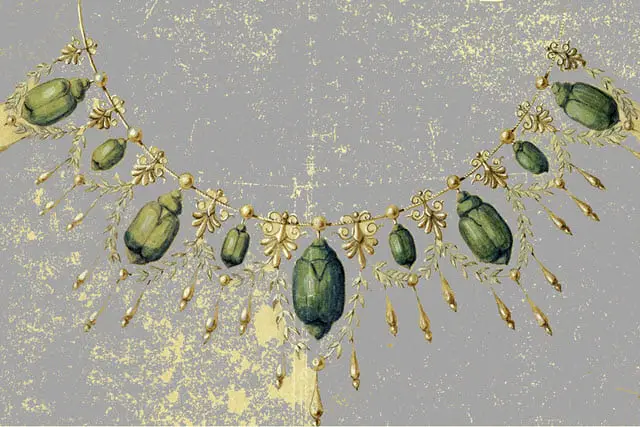
During the mourning period of Queen Victoria, she carried a locket made of Prince Albert’s hair around her neck. She was the epitome of mourning ensemble, jewelry, and behavior, inspiring the people of England and the United States to act accordingly.
She also instigated this quirky but common trend of the Victorian Era: decorating jewelry with the hair of a deceased loved one.
Many women wove floral wreaths with a wire and some hair of a dead relative. Similarly, wreaths of multiple people’s hairs, both alive and dead, were symbolic of a sentimental family tie.
As morbid as it sounds, perhaps because of a direct influence of the early Victorian or Romantic Era, love and sentiments were trapped in this jewelry.
Another quirky trend was insect jewelry. It was inspired by the ancient Mayan people, who often were bejeweled in amber insects. Women wove insects into wearable strings to restore their connection with nature, disrupted by the advent of the Industrial Revolution. As paradoxical as it sounds, women were obsessed with taxidermy.
It was even outrageous, but some women put fireflies on their hair while others directly sewed them onto their dresses. As this trend grew exponentially, many insects fell on the verge of extinction until the trend ceased.
18. Top Hats
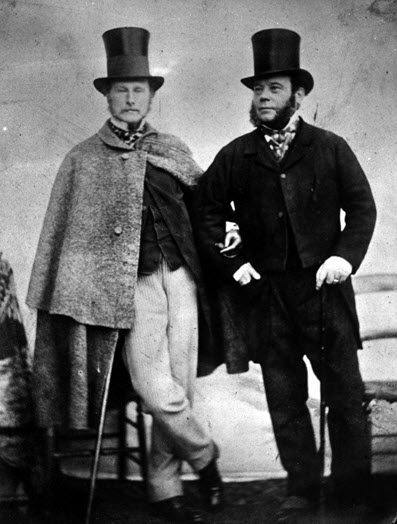
As significant as a bonnet to a woman, a top hat was a man’s defining accessory during the Victorian Era. Similarly, it too assumed varied shapes over time. It was, in fact, the most sophisticated and dominating hat in history.
John Hetherington, a haberdasher, stirred a commotion when he first adorned his head with a top hat. It invited a riot with women screaming, dogs barking, mob influx, and injuries at the sight of this tall structure.
Hetherington had simply modified the riding hat and was further modified by Antoine Gibus in 1823. However, it soon catapulted into a fashion craze when Prince Albert began publicly wearing it.
Although silk hats were popular, gentlemen preferred felted beaver skin hats more. There was a high demand for beaver skin hats for it was waterproof, and as a result, there was a decline of beavers in America by 1900.
The long and narrow Lincoln hat and the short and rounded straw hat were not to forget the oval derby hat for gentlemen. While planters and ranchers wore straw hats, commonly portrayed in movies such as Gone with the Wind, gentlemen wore tall hats for business and other occasions. They donned gray hats during the day and black for night.
Top hats were considered classy and sophisticated. They made the men look taller and suaver. Perhaps, it was the reason that they instantly became an indispensable accessory.
17. Frock Coats
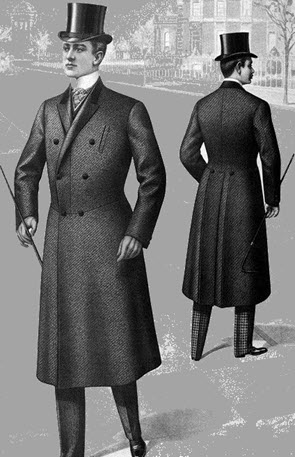
1816 was the year when frock coats emerged in the Victorian markets. The male silhouette of the cinched waist, puffy chest, and flared skirt at the bottom became the ideal hourglass figure for men. This particular trend passed on for years to come.
Although the height and length of the coats changed with fashion, it was generally considered to drop to the knee. As for the shoulder padding, it was a rare occurrence. However, the chest area was generously padded to make it appear round.
Humbly beginning from farming coats and sporting coats, it soon became the earner of respect among the urban population. It evolved into a formal dress worn during the day in the 1850s. Soon, it was a staple attire worn as a full dress in the evening.
As varied as the Victorian fashion trends, a morning coat emerged and superseded it. And by the end of the century, courtrooms and diplomatic pursuits only saw it.
In the Victorian Era, frock coats were measured according to the wearer’s size. Moreover, the lapels were detached and sewn separately to better the lapel roll. It also came with no outer pockets until the end of the 19th century.
For formal wear, a frock coat always had a peak lapel and was double-breasted, whereas for informal, men wore a notched-lapelled single-breasted coat.
Usually, tight tailor pants, formal shirts, formal gloves, and a cane were the best suited overall attire for men. Similarly, a vest or a waistcoat accompanied the frock coat on the inside.
16. Waist Coat
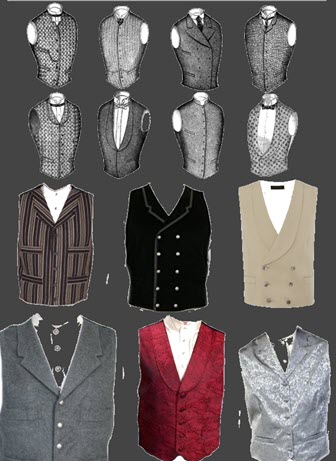
The waistcoat is also known as the Victorian vest, for it was a staple piece of clothing during that Era. In October 1666, King Charles II of England, Scotland, and Ireland made the world familiar with waistcoats when he introduced them. Hence, waistcoat becomes one of the few articles that can be exactly dated.
It is a sleeveless garment put over a shirt and followed by a necktie. It completed a man’s attire and also gave a hint of color to the sober ensemble. Yes, the waistcoat was made in contrast to the suit’s color.
They varied in lapels such as peak, shawl, or notched, and men alternated between double-breasted and single-breasted waistcoats.
It was only after 1850 that they got more stylish. The lapels were notched; the waistcoat got a new pocket at either of the sides of the buttoned center. The pocket was where men kept their handkerchief or pocket watch.
Similarly, it had a belt attached behind to tighten the middle part and accentuate the wearer’s waist. It served the same purpose as a corset for women.
During the Era, men who left their homes without donning a waistcoat were considered impolite. Only their wives could see them devoid of vests in their plain shirts. Waistcoat fabrics commonly were flannel, paisley, plaids, and stripes.
While these were the materials used by the upper class, the laborers made vests out of denim, dock canvas, or thicker cotton.
15. Bertha Neckline

A Bertha collar or neckline is a wide, flat, or round collar on women’s dresses that accentuates their shoulders. Not all women were allowed to carry a plunging neckline.
The women belonging to the high or middle classes would have clothes with Bertha collar designs, while it was restricted for the women of the lower class.
The Bertha Collar design dresses had lacy and very wide frill that could frame the evening gowns of the women of that period. Most of these frills had deep laces of around 6 inches.
It was another quintessential example of the Era’s elaborate dressing rather than utilitarianism.
Bertha’s collar was also fashioned in women’s wedding dresses, further juxtaposed with seed pearls and laces. A semi-opaque netting embroidery could opt for those who refused to show much flesh.
It made the dress more glamorous, and all upper-class Victorian women sought after this fashion trend. Some of the extant photographs from this Era reveal the wide use of a Bertha collar in their dresses.
This trend is still intact today, from high-end brands to local manufacturers, cape collars, off-shoulder, or even boat necks.
14. Shawl

Since the evening gowns were décolleté style, shawls became a necessary part of women’s ensembles. It was the most ubiquitous and versatile piece of clothing from the previous years’ fashion trends.
Shawls were available in all fabrics: muslin, silk, lace, and cashmere and were priced accordingly. Hence, every hierarchy of Victorian society could avail one. It is for its availability to even the lower class, shawls qualified as utilitarian.
Especially the cashmere or Kashmir shawls, manufactured in Kashmir, proved to be soft on touch and equally regal looking. Many kinds of literature depicting the Era hang on the soft and coveted cashmere shawls.
Even as the dresses got bulkier with layers of laces and fabrics, the place of the shawl as an important prop never declined. It was a reliable material for all women, no matter their type of dress.
13. Necktie
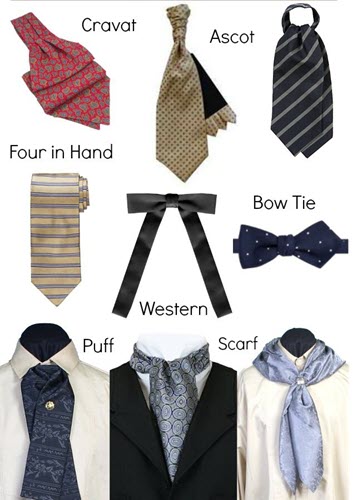
We have already established the importance of impeccable and often elaborate dressing in the Victorian Era. It called both men and women both paying attention to their sartorial styles. Men accessed what Prince Albert and the royal consort would publicly wear. One such influence was neckties.
Cravat or necktie came into fashion in the 1660s, when stylish men decorated their necks with embroidered cravats. They were a long white material with lace trimmings on the ends, neatly tied into a bow.
Stock replaced cravats, and gentlemen began buttoning the stiff folded cloth behind their necks. This fabric and style became popular in the early 18th century.
The 19th century saw a comeback of cravats with the dichotomy of two layers. By the mid-19th century, men tied cravats in a dashing bow. The black and colored cravats were generally tied, while white cravats were reserved for formal occasions.
Commonly used fabrics for neckties included solids, paisley, thin stripes, damask, and polka dots. Long neckties emerged only towards the era’s tail end and were a newer invention. They were also very skinny, often hand-knit or with a square block of satin at the end.
Neckties variegated as the decade progressed, and ascots, silk scarfs, silk puffs, Tech ties, and double ties (Doc Holliday style) emerged from different places.
12. Petticoats
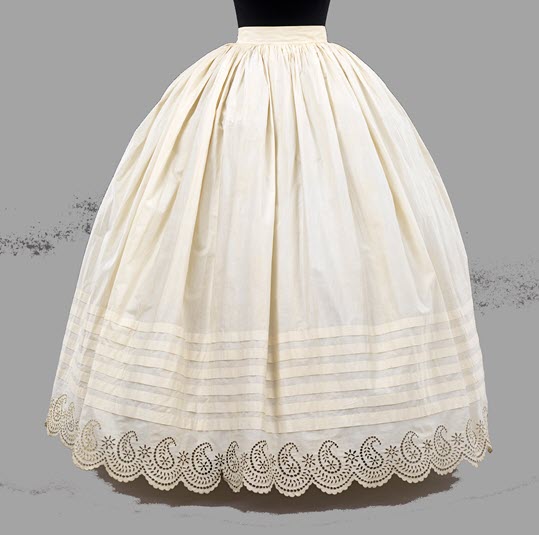
Clothing in the Victorian Era was strict, accompanied by numerous frills, ruffles, embroidery, crinolines, bustles, corsets, and petticoats at the helm. Petticoats performed two functions: under linen and structural garment. It protected the dress, disguised the contours of the legs, and provided warmth.
It was added to shape the dress and mirror the cut of the dress. The Victorian dresses were colored or corded, i.e., cords ran through the hems to help them hold out. Several petticoats hung over ladies’ bodies to impart a flounce look. With time, the number of dresses reduced, especially due to the cage crinolines.
However, after the fall of age cage, petticoats reestablished themselves with more decorated ruffles and colors than before. Scarlet decorated with black was the preferred design, assuming a narrow width.
Skirts and dresses were also gored, i.e., sewn-in panels narrowed at the top and wide at the bottom. Gored petticoats with horsehair became the main supporter of the skirt while also giving a conical shape to the dress.
Throughout the decade, the style of dresses changed, but people did not banish petticoats. The end of the Era also saw a detachable train attached to the dress. It became a symbol of femininity and was carried out even in the Edwardian Era.
11. Dresses
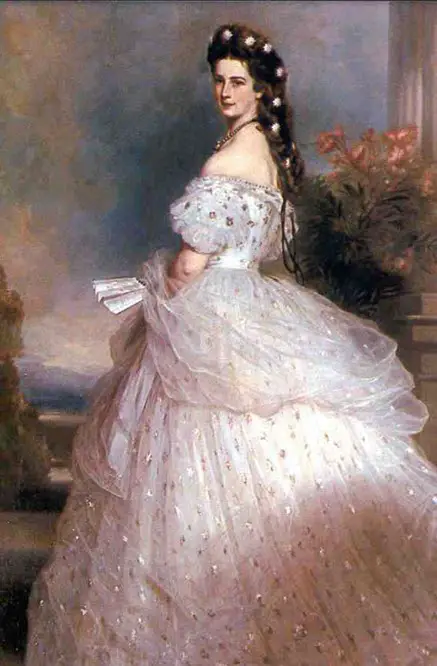
Women’s fashion during the Victorian Era largely resembled the Georgian Era’s. It placed high importance on etiquettes, so much so that women were restricted from showing their ankles. Similarly, it fenced women’s movements beneath a tiring ordeal of dresses, corsets, bustles, laces, and shawls from head to toe.
Bloomers were wide and often had ruffles at their seams. The common folks wore cotton stockings while the richer women wore silk or woolen. Next came the chemise with elaborate dressing again.
Then came the gut-wrenching (literally) corset, bustles, layers, and layers of the petticoat, and structured crinolines beneath their dresses.
The change of dress was as numerous as the items to be worn. An at-home dress was a simple garment with a high neckline, a hem touching the floor, and a little train. Similarly, afternoon dresses were lavish with a low neckline. Women wore afternoon dresses when they were expecting friends or going out with them.
Evening gowns were usually made of silk or other lustrous material. It has a high neckline and long sleeves, devoid of many trimmings to avoid accidents at the dinner table. The example mentioned above illustrates the dresses and rituals of the upper-class society. The lower-class women would wear what was affordable.
10. Crinoline
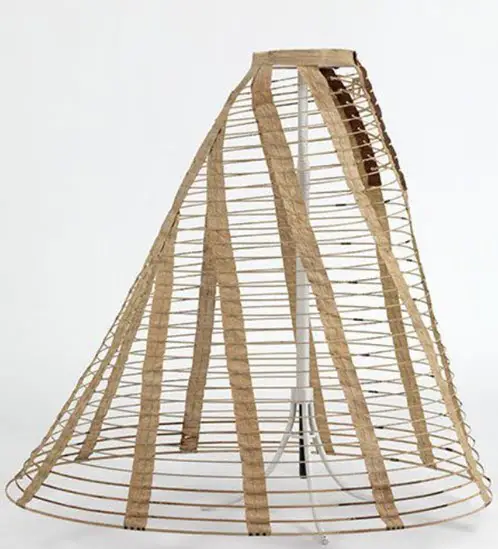
Crinolines need no introduction, for they have been synonymous with typical Victorian dressing: prim, proper, and outrageous. Women opted for crinolines to rescue themselves from complicated layers of petticoats while still keeping their busty backs intact.
Crinoline, a type of dress with a stiffened skirt made of horsehair, derived its name from ‘crin’ or horsehair in French and ‘lin’ for linen. The fashionable women from the 40s preferred crinolines, which transitioned into the light frame of metal spring hoops. Regardless of women’s types, they invariably created volume beneath the skirts. By the 1860s, even factory workers and maids were wearing them.
It was introduced by Catherine of Aragon, the first wife of Henry VIII, when she wore a Spanish farthingale of linen and cage sticks. This explains the presumption that farthingale in 15th century Spain preceded crinolines.
Women felt liberated from the blanket of petticoats after the advent of crinolines of hooped skirts. They simply wore a dress over the crinoline that seamlessly did the work. Ladies opted for flannel petticoats during the winter.
Crinolines were originally dome-shaped in the 50s that later modified into pyramid shapes a decade later. During the late 60s, it was devised into a small hoop before disappearing from fashion in 1878.
9. Bustles
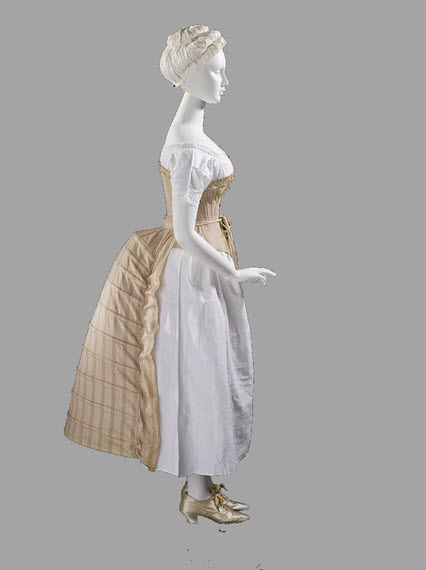
Bustles are one of the historical artifacts that are yet to penetrate the modern clothing scene. Yet, in the Victorian ages, it was a hype to adorn bustles at the back. Especially after many women fell prey to crinolines and their hazards, bustles manifested into a new trend that was comparatively benign.
Bustles didn’t encircle the body, nor did they give a bell shape to the body. It is hooked at the back to give it a busty appearance while flattening the front and the sides. The early bustles were worn low and made to accommodate the train, not forgetting the reality of women’s lives.
Typically constructed of steel and cotton, they were buckled or tied in the front, encouraging trains, frills, and the bodice.
During the 1870s, the focus shifted from bustles to embellishments on the trains of women’s dresses, particularly below the knees. Frills and laces were sewn onto the trains to make it flouncy and organza-styled.
After a hiatus, the bustle returned to mainstream fashion in what is called the second phase. This phase is characterized by a severely tailored figure that grew in the late 19th century.
An industrial support bustle developed to hold the weight of the explosion of fabrics that hung over it. The back of the gown was embellished prolifically with bows, frills, laces, pleats, and the like.
When women started hitting the streets during the rise of the 20th century, these clothing fads proved to be unsustainable because of their heaviness.
8. Bodice
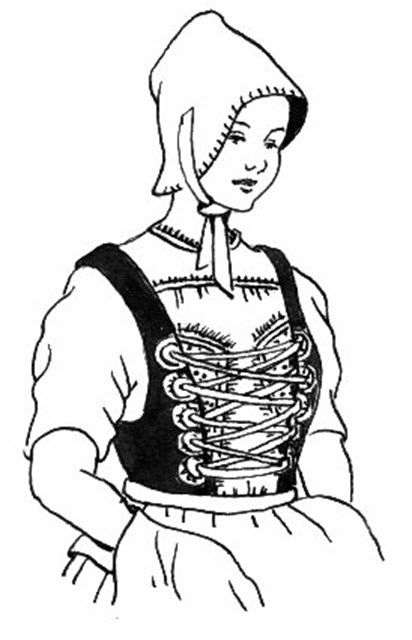
Victorian fashion is characterized by an emphasis on the waist and the breasts supposed to spring right under the chin.
Thus, the corsets and bodices were employed to achieve the right proportions. In the same Era, the necklines widened, and the bodice assumed a V-shape.
The bodice was a piece of garment that covered the torso, from the neck region to the waist. As the women of those times remained inactive and shy, the place of the bodice shifted from the shoulders to the upper arm to further restrict movement.
It also accentuated the V-shape figure as the ideal body type of the Victorian Era.
While the French bodices were firmly held against the skin, English bodices were gathered and trimmed with lace and ruffles. It was often called a ‘fan bodice’ because of its peculiar shape.
The trimmings began at the shoulders and were brought down to the waistline in a V-shape. A corset helped to attain a conical shape.
The jacket bodice did not attach to the skirt, which became popular in the 1850s. Often going well below the hips, these bodices were in contrast to the color of the dress.
Women experimented with a Spanish-style jacket over a blouse for a different look and seemed to love it.
Sometimes it was long, and other times cropped, worn during the daytime. Whereas for formal wear, the bodice consisted of two long points in front and three long points at the back. Regardless, it was a staple part of an ensemble that women loved.
7. Mourning Dress
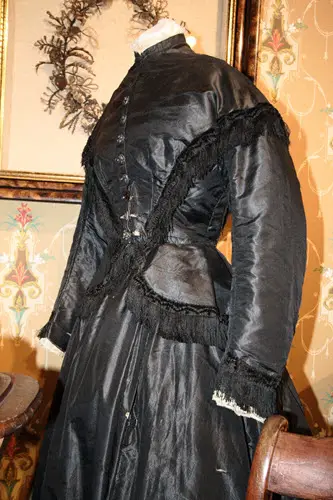
The mourning dress, similar to other fashion trends, was brought about by Queen Victoria herself. The Queen dressed in black for forty years after the death of her husband, Prince Albert. It made way to what we now know (and use) as the mourning dress.
The mourning years were very tough for widows as they were made to don only black ensembles and isolate themselves.
It was black crepe material with black piping on collars and cuffs and black buttons. Widow’s silk was an expensive jet black silk, especially worn during the mourning years.
Accessories such as gloves were also lined with black pipe along with the cuffs, and black pearls or jet stones were made into pendants.
As established, black dominated the wardrobe with black linings on all white articles. Dull black crepe immediately replaced lustrous articles such as top hats and gowns anytime a close one died.
Affording the mourning dress reflected social status among people of the Victorian Era. The affluent society stitched mourning clothes and matching bonnets for their maids.
None of the family members could leave the house without the all-black-everything fit. Women covered their faces with a black crepe weeping veil for full mourning.
Additionally, it popularized ready-to-wear clothes and catalogs that were hitherto not adopted.
6. Men’s Suit
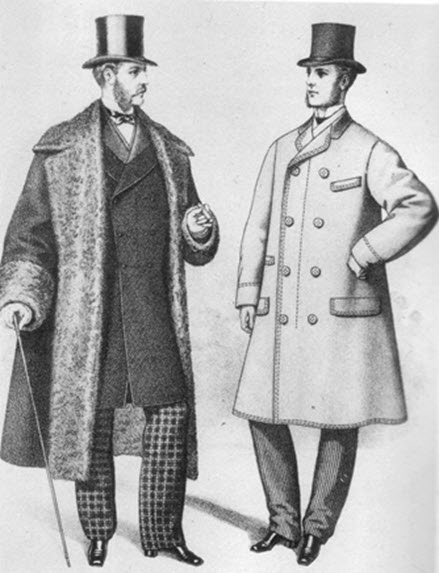
Prince Edward, the son of the reigning Queen, was a symbol of a male fashionista. He traveled the world and became an arbiter who brought trends in fashion-for instance, the three-piece suit.
As ready-to-wear clothes flourished, the accessibility of men on the lower rungs of the wealth ladder could afford shirts.
It was complex and often hectic to keep laundering their shirts, so people bought half a dozen detachable collars and cuffs as they were the only areas visible for public scrutiny.
The standard form of shirts was plain white, starched in washing to achieve a crisp look. Besides the standard form, men entertained patterned shirts. The collars were many, such as a standard fold down to wingtip and rounded banker collars to high standard collars.
Men could wear them interchangeably day-in and day-out, for they were detachable and easily afforded. Similarly, black was the standard color for men’s pants, but patterned pants also gained momentum.
Trousers were hung with suspenders as there were no belts in that Era. Moreover, button flies adorned the pants for zipper flies had not yet been discovered. Levi Strauss and his jeans forever changed the course of men’s fashion since their arrival in 1873.
5. Parasols

Women in this period never left their house without carrying a host of essential accessories. They included articles of practical purposes such as gloves, shoes, and ornaments, and somewhat frivolous such as the bonnet trimmed with exotic birds. One of them was parasols.
The middle of the 1850s was the year when Victorian people became familiar with parasols. They were foldable umbrellas with silk folds that instantly became trendy.
Since suntans and melanin were associated with peasants and maids, Victorian elites never wanted to contact the sun.
To avoid any sun exposure, women in the upper class and middle class started the trend of carrying a parasol. Parasols were unfurled to avert sunrays but were more than just that.
It was, as usual, a symbol of high class and wealth. Not everyone could afford a parasol, which came in elaborate nets and laces.
They were made of silk and a tassel at the top of the umbrella. Some of the exquisite ones came with tilting luster for tilting angles. Besides the top, the handles were also made of ivory for the have-all. While parasols were common to come with wooden handles, ivory was a luxury.
4. Cane

Apart from the three-piece suit, another trend that gentlemen in the Victorian Era followed was carrying a cane. Otherwise, the whole fit looked somewhat incomplete. Canes or walking sticks were a crucial part of the Victorian gentleman ensemble that men maintained.
Men carried walking sticks or canes not as an aid for walking but rather as a status symbol of wealth and power. Often, canes attributed authority, which men of the upper class so fondly carried. But it was completely birthed from a psychological perspective of men.
When people laid down their swords, they picked up canes in the 17th century. Kings carried specters, and in the same way, men sought to carry canes as if subtly asserting that the power was in their hands.
And they possessed not only one or two canes but a whole collection of canes.
The most common was an ivory-handled cane that most people owned. Wood was alien to Britain in the 16th century.
As time passed, variegated handles were manufactured with silver-pique work. Later on, the cane handles were even gilded on the wooden handle.
The collection of canes included a rustic cane for dog walks and a sober one for the office. Similarly, men took exotic wood and gorgeous handle cane to the opera.
There was a cane for an each-the sailor, the Duke, and even the peasants. All in all, it was an indispensable article.
3. Hand-fans

The most enduring role of a Victorian hand fan is the symbol of royalty, like that in the ancient period. Ladies’ hand fans had more aesthetic purpose rather than any other duty.
Delicate damsels of the Victorian Era carried hand fans to express their wealth and sometimes even their relationship status.
The crowd could predict a lot based on how a lady carried her hand fan. How she held it, carried it, and waved, it could potentially answer whether she was single, taken, or plain hot.
Women’s magazines and journals discussed it. Thus, making it a universal language.
During the beginning of the 19th century, hand fans were not a thing. They came in simple models with thin leaves of spangled silk, and their handles were plain and not ornamented.
Only during or after the 1840s did the fans of the previous manner arrive. Soon, the leaves were dotted with mother-of-pearl and ivory sticks.
Each vellum leaf had a delicate painting, and the handles were gilded. It offered the fans an exquisite design and catapulted fashion rage.
Illustration on the fan copied from 18th-century fans and paintings a la Watteau. Similarly, fans in this period were imported from France, China, and Japan.
2. Bonnets

Until the mid-19th century, bonnets were mandatory for all girls and women. Initially used for protection from the sun and injuries, it soon became a symbol of wealth and authority. It was a style statement that both males and females wore.
Bonnets framed a woman’s face and were an important headgear in the Victorian Era. It differed in style from the large bonnet, small bonnet, tall and short hat, and plain versus elaborately decorated.
Not on that, there were different bonnets for different occasions such as riding, walking, partying, and home use.
The most famous straw bonnets were made of straws from Tuscany, plaited in Italian style. Other variations were silk bonnets gathered at the front and tied at the back.
The year 1838 introduced cottage bonnets that assumed brim and a crown continuous in a straight line.
From the mid-40s, open straw plaits mixed with horsehair were plated in fancy braids. Velvet was often a winter fabric for making bonnets. In the 50s, an open bonnet arrived that was low and sloping at the back.
The 60s saw a trend of spoon-shaped bonnets. It was most ornately designed with velvet, crepe, flowers, feathers, and ribbons.
Sometimes women went to length to adorn their hats with stuffed birds, which led to a decline in the population of birds.
That was when a Victorian PETA jumped to rescue and restore birds. All in all, the Victorian bonnets were of various styles and shapes, catering to the needs of women.
1. Corsets
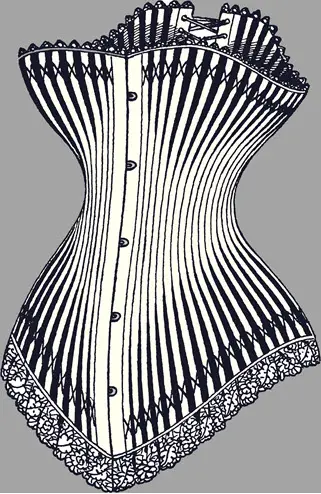
Corsets were an integral part of women’s undergarments in the Victorian Era. Primarily designed to improve the female figure, it had a lace-up at the center back to adjust the firmness.
Corsets were worn by women of all ages, from young girls to adult women. It corrected the posture of young girls and symbolized being high-class among adult women.
However, corsets never touched the skin directly as cotton chemise always preceded them.
Women of the Victorian period raised a family and tended to their husbands. It was one of the reasons why women donned corsets, and extremely tightened ones at that, to impede their activities.
Tightlacing further cinched their waists, projecting an even more curvaceous body that was popular during the 19th century.
New types of corsets included those that extended a little below the waist. It was also introduced for sporty women who later were involved in male-dominated activities and an abdominal corset for pregnant ladies.
Regardless of the conventional or new corset type, women invariably used it to give an hourglass figure.
It distinguished women of the high class who had no burden of household chores from those of the low class who had bulging bodies. It had more cons than pros because it deformed female anatomy and caused miscarriages, infertility, and other hazards.
Related:
Conclusion
The Victorian Era was an era of vanity for men and women. The reign of Queen Victoria was a reason for supplementing this highly fashionable century.
She introduced the elaborate bonnet from her coronation to the mourning dress and black pearls after the death of her husband, Prince Albert. And, so, it was Prince Albert who instigated many trends for the gentlemen.
Since ready-made tailoring was no longer a preserved privilege of the upper-class, many professionals adapted it.
The dress was very strict in those times, and anybody who dressed incorrectly was censured from entering influential society. Similarly, etiquette, gait, and how women carried their dresses were equally important.
Deducing was an era of appearances that introduced many trends sought after by fashionmongers of this century.
